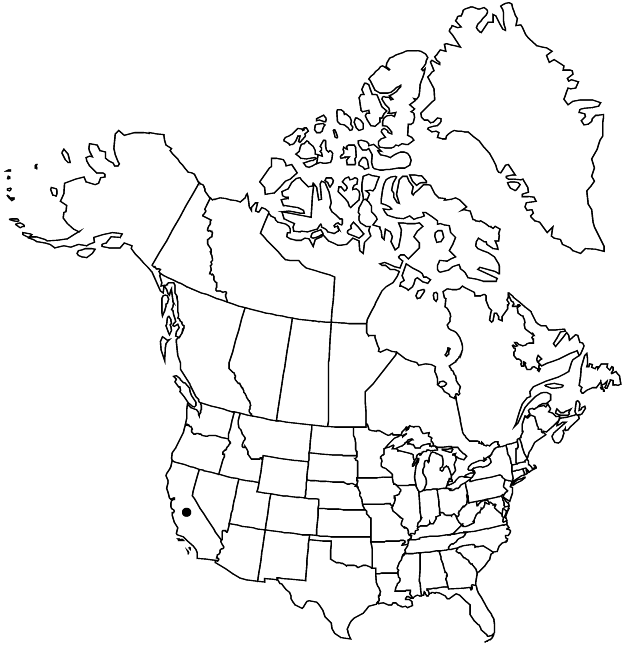Difference between revisions of "Chorizanthe spinosa"
in W. H. Brewer et al., Bot. California 2: 481. 1880.
FNA>Volume Importer |
FNA>Volume Importer |
||
| Line 27: | Line 27: | ||
|elevation=600-1300 m | |elevation=600-1300 m | ||
|distribution=Calif. | |distribution=Calif. | ||
| − | |discussion=<p>G. J. Goodman (1934) referred Chorizanthe spinosa to Eriogonella, but C. spinosa and C. membranacea, the type of Eriogonella, are well isolated from one another, and both are well removed from the remainder of the annual spineflowers. The Mojave spineflower is local and uncommon from southeastern Kern and southern Inyo counties, south into adjacent northeastern Los Angeles and northwestern San Bernardino counties to Antelope and Lucerne valleys.</p> | + | |discussion=<p>G. J. Goodman (1934) referred <i>Chorizanthe spinosa</i> to Eriogonella, but <i>C. spinosa</i> and <i>C. membranacea</i>, the type of Eriogonella, are well isolated from one another, and both are well removed from the remainder of the annual spineflowers. The Mojave spineflower is local and uncommon from southeastern Kern and southern Inyo counties, south into adjacent northeastern Los Angeles and northwestern San Bernardino counties to Antelope and Lucerne valleys.</p> |
|tables= | |tables= | ||
|references= | |references= | ||
| Line 51: | Line 51: | ||
|publication year=1880 | |publication year=1880 | ||
|special status= | |special status= | ||
| − | |source xml=https://jpend@bitbucket.org/aafc-mbb/fna-data-curation.git/src/ | + | |source xml=https://jpend@bitbucket.org/aafc-mbb/fna-data-curation.git/src/8f726806613d60c220dc4493de13607dd3150896/coarse_grained_fna_xml/V5/V5_932.xml |
|subfamily=Polygonaceae subfam. Eriogonoideae | |subfamily=Polygonaceae subfam. Eriogonoideae | ||
|genus=Chorizanthe | |genus=Chorizanthe | ||
Revision as of 17:42, 18 September 2019
Plants spreading to prostrate, 0.3–0.8(–1) × 0.5–8 dm. Leaves basal; petiole 0.5–2 cm; blade (0.3–)0.5–1.5(–2) × (3–)5–10(–12) mm, thinly pubescent adaxially, more densely so to tomentose abaxially. Inflorescences greenish to reddish, mostly flat-topped and open to dense; bracts 3, whorled, short-petiolate, linear-lanceolate to lanceolate, acerose, 0.5–1.5 cm × 3–8(–10) mm, awns straight, 1–3.5 mm. Involucres usually congested in small terminal clusters of 1–3 at node of dichotomies, (4–)5-ribbed, weakly 3-angled, 2–2.5 mm, not corrugate, densely canescent; teeth (4–)5, essentially erect with longer, prominent, and thickened anterior one 2–4 mm, with straight awn 1–2.5 mm, remaining teeth smaller, 0.5–1 mm, with straight awns 0.3–0.8 mm. Flowers 1, exserted; perianth, cylindric, 2.5–3.5 mm; tepals connate 1/2–2/3 their length, dimorphic, entire, those of outer whorl spreading, broadly obovate and rounded apically, those of inner whorl erect, narrowly oblanceolate, 1/2 length of outer ones, acute apically; stamens slightly exserted; filaments 2.5–3 mm, glabrous; anthers yellowish, oblong, 0.5–0.7 mm. Achenes 2.5–3 mm. 2n = (40), 44, (46).
Phenology: Flowering Apr–Jul.
Habitat: Sandy to gravelly flats and slopes, saltbush communities
Elevation: 600-1300 m
Discussion
G. J. Goodman (1934) referred Chorizanthe spinosa to Eriogonella, but C. spinosa and C. membranacea, the type of Eriogonella, are well isolated from one another, and both are well removed from the remainder of the annual spineflowers. The Mojave spineflower is local and uncommon from southeastern Kern and southern Inyo counties, south into adjacent northeastern Los Angeles and northwestern San Bernardino counties to Antelope and Lucerne valleys.
Selected References
None.
